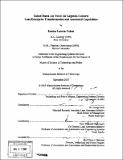| dc.contributor.advisor | George Roth. | en_US |
| dc.contributor.author | Cohen, Jessica L. (Jessica Lauren) | en_US |
| dc.contributor.other | Massachusetts Institute of Technology. Technology and Policy Program. | en_US |
| dc.date.accessioned | 2008-02-27T22:17:49Z | |
| dc.date.available | 2008-02-27T22:17:49Z | |
| dc.date.copyright | 2005 | en_US |
| dc.date.issued | 2005 | en_US |
| dc.identifier.uri | http://hdl.handle.net/1721.1/40381 | |
| dc.description | Thesis (S.M.)--Massachusetts Institute of Technology, Engineering Systems Division, Technology and Policy Program, 2005. | en_US |
| dc.description | Includes bibliographical references (p. 180-183). | en_US |
| dc.description.abstract | Lean enterprise transformation entails a complementary set of initiatives and efforts executed over a substantial period of time, in a consistent and coordinated manner, at all levels of the enterprise. It builds upon ordinary organizational change in that a broader set of people and functions will be affected, and non-traditional approaches and mental models will continue to be exercised. I have developed and proposed a set of capabilities that must be possessed by any enterprise in order for that enterprise to successfully transform and sustain a new way of doing business. These capabilities have been drawn and compiled from a combination of organizational change literature and models, as well as personal experience and observations. Between 2003 and the present, three US Air Force Air Logistics Centers (ALCs) initiated lean enterprise transformation efforts. This notion was beyond the activities these sites pursued in the past, as the ALCs were challenged to see their enterprises as a system that needed to be optimized. I have used the capabilities developed to assess each ALC and make suggestions regarding their future needs in executing lean enterprise changes. | en_US |
| dc.description.abstract | (cont.) In particular, I have focused on two of the twelve capabilities (a leadership team with a shared mental model and a balanced and cascading system of metrics), and compared each ALC to an ideal state and utilization of these capabilities. Further, I have examined the Warner Robins ALC with respect to all twelve capabilities, in light of past work conducted at the site. The results of this research are two-fold. First, I have learned that there are certain conditions that must be met before lean enterprise transformation can be attempted and sustained. The readiness necessary can be assessed within a combination of the qualitative results derived from a comparison with the ideal capabilities I have defined, along with the quantitative results reported with the LAI Lean Enterprise Self Assessment Tool. Second, I have determined that there are special practices and cultural aspects of government enterprises that makes lean enterprise transformation particularly difficult for them. This is the result of policies in place, and a tradition of strategic direction being handed down from above. | en_US |
| dc.description.statementofresponsibility | by Jessica Lauren Cohen. | en_US |
| dc.format.extent | 185 p. | en_US |
| dc.language.iso | eng | en_US |
| dc.publisher | Massachusetts Institute of Technology | en_US |
| dc.rights | M.I.T. theses are protected by copyright. They may be viewed from this source for any purpose, but reproduction or distribution in any format is prohibited without written permission. See provided URL for inquiries about permission. | en_US |
| dc.rights.uri | http://dspace.mit.edu/handle/1721.1/7582 | |
| dc.subject | Technology and Policy Program. | en_US |
| dc.title | United States Air Force Air Logistics Centers : lean enterprise transformation and associated capabilities | en_US |
| dc.title.alternative | USAF ALCs : lean enterprise transformation and associated capabilities | en_US |
| dc.type | Thesis | en_US |
| dc.description.degree | S.M. | en_US |
| dc.contributor.department | Massachusetts Institute of Technology. Engineering Systems Division | |
| dc.contributor.department | Technology and Policy Program | |
| dc.identifier.oclc | 191100862 | en_US |
